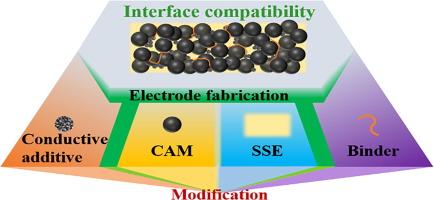硫化物固体电解质与富镍氧化物阴极材料之间的界面兼容性:因素、改性和前景
IF 13.1
1区 化学
Q1 Energy
引用次数: 0
摘要
由硫化物固体电解质(SSE)和富镍氧化物阴极材料组装而成的全固态电池(ASSB)有望实现高能量密度和安全性,是下一代储能系统的潜在候选材料。然而,由空间电荷层、界面副反应和机械接触失效引起的 SSE 与富镍氧化物阴极材料之间的界面问题极大地限制了 ASSB 的性能。界面退化与复合阴极的成分和电极制造工艺密切相关。本文以 SSE 与富镍氧化物阴极界面相容性的影响因素为重点,系统地讨论了阴极活性材料 (CAM)、电解质、导电添加剂、粘结剂和电极制造如何影响界面相容性。此外,还综述了相容性改性的策略。此外,还讨论了深入研究 SSE/富镍阴极材料界面降解和改性所面临的挑战和前景。本综述旨在为高能量密度和高安全性全固态电池的开发提供启发。本文章由计算机程序翻译,如有差异,请以英文原文为准。

Interface compatibility between sulfide solid electrolytes and Ni-rich oxide cathode materials: factors, modification, perspectives
All-solid-state batteries (ASSBs) assembled with sulfide solid electrolytes (SSEs) and nickel (Ni)-rich oxide cathode materials are expected to achieve high energy density and safety, representing potential candidates for the next-generation energy storage systems. However, interfacial issues between SSEs and Ni-rich oxide cathode materials, attributed to space charge layer, interfacial side reactions, and mechanical contact failure, significantly restrict the performances of ASSBs. The interface degradation is closely related to the components of the composite cathode and the process of electrode fabrication. Focusing on the influencing factors of interface compatibility between SSEs and Ni-rich oxide cathode, this article systematically discusses how cathode active materials (CAMs), electrolytes, conductive additives, binders, and electrode fabrication impact the interface compatibility. In addition, the strategies for the compatibility modification are reviewed. Furthermore, the challenges and prospects of intensive research on the degradation and modification of the SSE/Ni-rich cathode material interface are discussed. This review is intended to inspire the development of high-energy-density and high-safety all-solid-state batteries.
求助全文
通过发布文献求助,成功后即可免费获取论文全文。
去求助
来源期刊

Journal of Energy Chemistry
CHEMISTRY, APPLIED-CHEMISTRY, PHYSICAL
CiteScore
19.10
自引率
8.40%
发文量
3631
审稿时长
15 days
期刊介绍:
The Journal of Energy Chemistry, the official publication of Science Press and the Dalian Institute of Chemical Physics, Chinese Academy of Sciences, serves as a platform for reporting creative research and innovative applications in energy chemistry. It mainly reports on creative researches and innovative applications of chemical conversions of fossil energy, carbon dioxide, electrochemical energy and hydrogen energy, as well as the conversions of biomass and solar energy related with chemical issues to promote academic exchanges in the field of energy chemistry and to accelerate the exploration, research and development of energy science and technologies.
This journal focuses on original research papers covering various topics within energy chemistry worldwide, including:
Optimized utilization of fossil energy
Hydrogen energy
Conversion and storage of electrochemical energy
Capture, storage, and chemical conversion of carbon dioxide
Materials and nanotechnologies for energy conversion and storage
Chemistry in biomass conversion
Chemistry in the utilization of solar energy
 求助内容:
求助内容: 应助结果提醒方式:
应助结果提醒方式:


